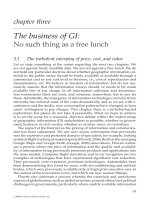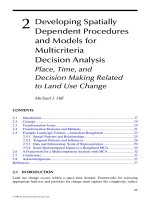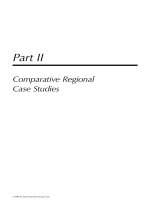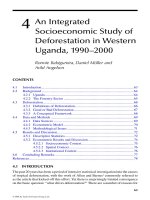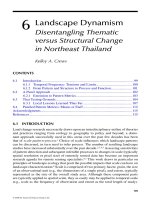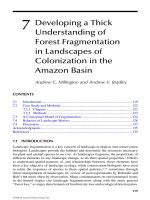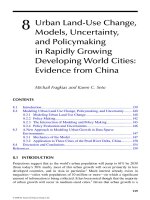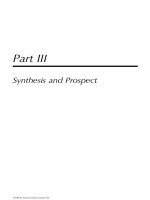Land Application of Sewage Sludge and Biosolids - Chapter 3 docx
Bạn đang xem bản rút gọn của tài liệu. Xem và tải ngay bản đầy đủ của tài liệu tại đây (126.49 KB, 12 trang )
CHAPTER
3
Plant Nutrients
INTRODUCTION
Plant nutrients can be subdivided into major nutrients and minor or micronutri-
ents. Three of the major nutrients, nitrogen (N), phosphorus (P), and potassium (K),
are the most important and are utilized to the greatest extent. These three plant
nutrients are the ingredients listed on fertilizers sold at stores. Calcium (Ca), mag-
nesium (Mg), and sulfur (S) are also major nutrients since the plant utilizes them
to a greater extent than minor or micronutrients. The micronutrients essential to
plant growth are boron (B), copper (Cu), iron (Fe), manganese (Mn), molybdenum
(Mo), nickel (Ni), and zinc (Zn).
It has been recognized for centuries that sewage sludge and biosolids contain
plant nutrients. Noer (1926) cited Bruttini (1923), who estimated that the annual
excrement of the world’s population contains approximately 9 million tons of nitro-
gen (N) and close to a million tons of phosphoric acid (P
2
O
5
) and potash (K
2
O) that
are lost to agriculture. Based on this data, Noer (1926) estimated that the annual
loss to the United States is approximately 0.5 million tons of N valued at $180
million, and more than 100,000 tons each of P
2
O
5
, valued at $12 million, and K
2
O,
valued at $10 million.
Today this number would be much higher. It is estimated that the U.S. produces
approximately 2 million dry tons of sludge and biosolids. This approximates to 10
million wet tons. Assuming an average of 4% nitrogen, the N in sewage sludge and
biosolids would amount to about 400,000 tons that could be available to crops.
Approximately 250,000 tons of P would be available to crops. In addition, significant
quantities of minor elements Ca, Mg, and S would be available. In many cases, soils
in the United States are deficient in these nutrients and farmers must add them at
significant cost.
In 1977, Sommers obtained data on the nutrient content in 250 sewage sludge
samples from 150 wastewater treatment plants. The data on the major plant nutrients,
including calcium (Ca), magnesium (Mg), and sulfur (S), are presented in Table 3.1.
Nitrogen, P, Ca, and S are present in relatively large amounts, whereas K and Mg
are found in much smaller amounts.
©2003 CRC Press LLC
The nitrogen cycle depicted in Figure 3.1 shows the various transformations that
occur when biosolids are applied to land.
When biosolids are incorporated into the soil, the organic matter immediately
begins to decompose by the microbes in the soil or those in the biosolids, as long
as temperatures are above freezing and there is sufficient moisture. Even at low
Table 3.1 Concentrations of Total N, P, K, Ca, Mg and S in Sewage Sludge and
Biosolids
Plant Nutrient
Sample
Type Number Range Median Mean
Total % N Anaerobic 85 0.5–17.6 4.2 5.0
Aerobic 38 0.5–7.6 4.8 4.9
Other 68 <0.1–10.0 1.8 1.9
All 191 <0.1–17.6 3.3 3.9
NH
4–
N, ppm
Anaerobic 67 120–67,600 1,600 9,400
Aerobic 33 30–11,300 400 950
Other 3 5–12,500 80 4,200
All 103 5–67,600 920 6,540
NO
3–
N, ppm
Anaerobic 35 2–4,900 79 520
Aerobic 8 7–830 180 300
Other – – – –
All 43 2–4,900 170 490
Total % P Anaerobic 86 0.5–14.3 3.0 3.3
Aerobic 38 1.1–5.5 2.7 2.9
Other 65 <0.1–3.3 1.0 1.3
All 189 <0.1–14.3 2.3 2.5
Total % K Anaerobic 86 0.02–2.64 0.30 0.52
Aerobic 37 0.08–1.10 0.38 0.46
Other 69 0.02–0.87 0.17 0.20
All 192 0.02–2.64 0.30 0.40
% Ca Anaerobic 87 1.9–20.0 4.9 5.8
Aerobic 37 0.6–13.5 3.0 3.3
Other 69 0.1–25.0 3.4 4.6
All 193 0.1–25.0 3.9 4.9
% Mg Anaerobic 87 0.03–1.92 0.48 0.58
Aerobic 37 0.03–1.10 0.41 0.52
Other 65 0.03–1.97 0.43 0.50
All 189 0.03–1.97 0.45 0.54
% S Anaerobic 19 0.8–1.5 1.1 1.2
Aerobic 9 1.6–1.1 0.8 0.8
Other – – – –
All 28 0.6–1.5 1.1 1.1
Source
: Sommers, 1977,
J. Environ. Qual.
6: 225–232. With permission.
©2003 CRC Press LLC
temperatures and under drought, decomposition proceeds at a very slow pace as a
result of the heat and moisture of the decomposing organisms. Microorganisms
utilize the carbon as a source of energy, and the nitrogen for cell development and
growth.
The nitrogen components in biosolids are predominantly organic. These have
been identified as proteinaceous, amino acids and hexosamines. Parker and Sommers
(1983) found that, for anaerobically digested biosolids, organic N ranged from 0.501
to 3.033%. Ammonium nitrogen (NH
4
+
–N) ranged from 0.0026 to 0.3760%. Nitrate
nitrogen (NO
3
–
–N) was extremely low. Their data are summarized in Table 3.2.
NITROGEN
When biosolids are applied to land, the predominantly organic nitrogen under-
goes numerous transformations. These transformations are extremely important as
they affect plant growth, microbial activity, and reactions through the soil. The
transformation of nitrogen in soil resulting from biosolids application is affected by
several important conditions in the biosolids and the soil. These include:
Figure 3.1
The nitrogen cycle when biosolids are applied to land. Many of these conditions
are interrelated. (From Epstein et al., 1978,
J. Environ. Qual
. 7: 217–221. With
permission.)
AMMONIA
VOLATILIZATION
UPTAKE BY
PLANTS
LAND
APPLICATION
OF BIOSOLIDS
ORGANIC
NITROGEN
AMMONIFICATION
NH
4
+
NITRIFICATION
NO
2
-
NITRATE
NO
3
-
IMMOBILIZATION
FIXATION
ON CLAY
RUNOFF
(SEDIMENTS)
IMMOBILIZATION
SOIL
MICROORGANISMS
AND ORGANIC
MATTER
LEACHING RUNOFF
GROUNDWATER
ODOROUS
REDUCED N
COMPOUNDS TO
AIR
GASEOUS LOSES
N
2
DENITRIFICATION
©2003 CRC Press LLC
• Moisture content of soil
• Temperature of soil
• Rate of mineralization
• Oxidation
• Aeration
• Soil porosity
• Biosolids characteristics
• Rate of microbial activity
The nature of the end products depends on the presence or absence of oxygen
during the decomposition of the organic N in biosolids. In the presence of oxygen
(aerobic conditions) the products are humus-like, nitrogen-containing products that
become increasingly resistant to oxidation as decomposition progresses. Ammonia,
which is released, can escape into the atmosphere or be converted to nitrites and
then to nitrates. In the absence of oxygen (anaerobic conditions) the end products
are humus-like materials, ammonia, and nitrogen gas.
Ammonification
Ammonification is the conversion of organic N into ammonium N (NH
4
–N) by
numerous heterotrophic soil organisms. This form of N is available to plants, but it
generally does not leach through the soil, because the positively charged cation
(NH
4
+
) is held on the surface of negatively charged soil particles. This is termed
fixation. Leaching can occur in sandy soils since the cation exchange capacity of
these soils is low. NH
4
–N attached to soil particles can contaminate surface waters
through runoff and erosion.
Table 3.2
Carbon and Nitrogen Characteristics of Biosolids
Plant No. and Type of
Biosolids
Organic
C
Inorganic
C
Organic
N
Inorganic N
NH
4
+
Inorganic N
NO
2
–
+ NO
3
–
%%%
µµ
µµ
g/g
µµ
µµ
g/g
1. Aerobically digested 17.61 0.16 2.519 1360 44
1. Anaerobically digested 18.15 2.06 0.728 590 28
2. Aerobically digested 25.14 0.12 2.346 930 16
3. Aerobically digested 25.32 0.77 3.033 3760 33
4. Aerobically digested 17.47 1.67 1.654 340 1010
5. Anaerobically digested 27.58 1.05 2.744 2010 22
6. Anaerobically digested 11.75 1.87 1.048 56 780
7 Anaerobically digested 21.49 0.75 1.890 1490 120
8. Anaerobically digested 16.72 1.44 1.279 130 18
9. Anaerobically digested 6.78 5.18 0.501 26 90
10. Anaerobically digested 11.97 0.14 1.082 610 2100
11. Anaerobically digested 28.51 0.88 2.006 490 550
12. Anaerobically digested 16.08 0.16 1.692 2440 170
13. Anaerobically digested 15.32 1.66 1.403 630 32
Source
: Adapted from Parker and Sommers, 1983.
©2003 CRC Press LLC
Nitrification
Nitrification involves two steps. First NH
4
+
is oxidized to nitrite (NO
2
–
) by
Nitrosomonas
spp. bacteria. Then NO
2
–
is oxidized to nitrate (NO
3
+
) by
Nitrobacter
spp. bacteria. Possibly other species are involved (Tate, 1995). Nitrate is readily
available to plants. Nitrite-nitrogen is negatively charged and not adsorbed on soil
particles. It thus remains in the soil solution and can be leached below the root zone
and percolate into groundwater.
Immobilization
Immobilization is the tying up of nitrogen by soil organisms. When residues
high in carbon are incorporated into the soil, the available N is used by the soil
microorganisms that decompose the organic matter. Uncured biosolids compost, for
example, when incorporated into the soil, will continue to decompose at a fairly
high rate and the soil microorganisms will utilize the available N. This can sometimes
be evident by yellowing (nitrogen deficiency) of plants. Although the N immobilized
as microbial protein is later mineralized during decomposition, it can significantly
reduce NO
3
–
–N leaching during periods when crop uptake of N is reduced.
Biosolids-applied N may be immobilized into soil organic matter or remain as
refractory organic N (Permi and Cornfield, 1969; Ryan et al., 1973).
Denitrification
Denitrification is the biological reduction of NO
3
–
or NO
2
–
to gaseous forms of
N, usually N
2
O and N
2
. The process is extremely rapid. The predominant bacteria
are
Pseudomonas
or
Alcaligenes
(Tate, 1995). Under anaerobic conditions, the
nitrogen in the soils is transformed into nitrogen gas and is released to the atmo-
sphere. Since 80% of atmospheric gas consists of N, this addition of N is insignif-
icant. This process primarily occurs in poorly aerated soils and waterlogged soils.
After several days of waterlogged soils, much of the NO
3
–
N is lost by denitrification.
For denitrification to occur, decomposable organic matter must be present. Using
liquid anaerobically digested biosolids can result in significant amounts of N losses
by denitrification (Kelling et al., 1977). Several studies have indicated that denitri-
fication is a major source of N loss when biosolids are applied (Kelling et al., 1977;
Sommers et al., 1979).
Volatilization
When biosolids are applied to the soil surface, some volatilization of ammonia
will occur. Any N volatilized is not available to plants or potentially available to be
leached and contaminate groundwater. The amount of N volatilized from surface
application of biosolids can vary significantly. Numerous studies attempted to eval-
uate the losses of N from land application of biosolids (Ryan and Keeney, 1975;
Terry et al., 1978; Beauchamp, et al., 1978; Adamsen and Sabey, 1987; Robinson
©2003 CRC Press LLC
and Polglase, 2000). These studies indicate that the percentage of NH
4
+
–N can vary
from less than 1% to 100%. The majority of N is volatilized during the first few days.
Robinson (1999) reported that when dewatered biosolids were applied in the
field, 85% of NH
4
+
–N was lost within the first 3 weeks of application. In a subsequent
study, Robinson and Polglase (2000) indicated that majority of NH
4
+
–N was lost
during the first week and 71% to 81% was lost during the first 14 days.
Mineralization
Mineralization is the conversion of organic N to inorganic N. Organic N is first
converted to NH
4
+
in a process termed ammonification. Then NH
4
+
is oxidized to
NO
2
–
by
Nitrosomonas
bacteria and NO
2
–
is oxidized to NO
3
–
. This process is called
nitrification.
Thus, mineralization is the combination of ammonification and nitrification,
whereby the organic N is converted to NH
4
+
–N and later to NO
3
–
–N. The rate-limiting
step in soil N mineralization is the conversion of organic N to NH
4
+
–N. Under con-
ditions of adequate aeration and soil moisture and over a broad range of temperatures,
the NH
4
+
–N is rapidly oxidized to NO
3
–
–N (Stanford and Epstein, 1974).
Knowledge of the rate of nitrogen mineralization is important in determining
the rate of biosolids application, potential for crop uptake, and potential for leaching.
The amount of N mineralized is a function of several environmental factors and the
type of biosolids applied. Chae and Tabatabai (1986) indicated that the rate of N
mineralization is dependent on moisture, temperature, C:N ratio, and biosolids
properties.
Figure 3.2 shows the rate of nitrogen mineralization for digested biosolids and
composted biosolids as related to the amount of N applied per hectare (Epstein et
al., 1978). Considerably more N was mineralized from the biosolids (41%) than
from the compost (8.5%). The amount of N applied did not affect the percentage
mineralized.
Table 3.3 summarizes the data obtained by numerous investigators. The variabil-
ity shown in this table can be due to the type of biosolids and its condition, as well
as the soils used in the studies. The extent of anaerobic or aerobic digestion and the
initial N content will affect the organic N mineralization rate. Both composting and
alkaline stabilization reduce the amount of N in biosolids, thus reducing the amount
of N available for mineralization. Parker and Sommers (1983) indicate that immo-
bilization of N may be a significant process in many soils treated with biosolids.
They found that the amount of mineralizable N in biosolids was proportional to the
total organic N. The anaerobic digestion or composting of primary, raw or waste
activated sludges resulted in reduced organic N levels and decreased the potential
amount of mineralizable N.
USEPA and the various states require that the rate of biosolids application be in
relation to the crop requirement for nitrogen. This restriction is designed to avoid
excess N and prevent leaching to groundwater. Consequently, the transformations
that occur in the soil following biosolids application are extremely important. Nitro-
gen mineralization is the most important transformation since it releases inorganic
©2003 CRC Press LLC
N compounds which either are taken up by plants, immobilized, denitrified, or
leached to groundwater. Therefore, it is important to know the potential mineraliza-
tion rate for a given biosolids in relation to soil and climatic conditions.
PHOSPHORUS
Phosphorus (P) is an essential plant nutrient. It has been indicated that P defi-
ciency is the second most important soil fertility problem throughout the world
(Lindsey et al., 1989). However, excessive amounts of P in the soil tend to immobilize
other chemical elements such as zinc (Zn) and copper (Cu) that are also essential
Figure 3.2
Inorganic nitrogen mineralization from digested biosolids (DB) and composted
digested (CD) biosolids (From Epstein et al., 1978,
J. Environ. Qual.
7: 217–221.
With permission.)
Table 3.3
Nitrogen Mineralization Rates of Biosolids
Biosolids
Type
Incubation
Period
Percent
Mineralized Source
Anaerobically digested 16 weeks 4–48 Ryan et al., 1973
Anaerobically digested 36–41 Sabey et al., 1975
Anaerobically digested 13 weeks 14–25 Magdoff and Chromec, 1977
Anaerobically digested 15 weeks 40–42 Epstein et al., 1978
Aerobically digested 17 weeks 54–55 Magdoff and Amadon, 1980
Anaerobically digested 32 weeks 56.4–71.6 Lindmann and Cardenas, 1984
Composted digested 15 weeks 7–9.3 Epstein et al., 1978
Composted digested 54 days 6 Tester et al., 1977
g N/g soil kg N/ha
)
013579111315
0
100
200
300
400
500
600
INCUBATION TIME- WEEKS
484CD
484BD
907CD
907DB
1814CD
1814DB
©2003 CRC Press LLC
for plant growth (Chang et al., 1983). Excessive P in soil can result in nonpoint
source pollution of surface waters and shallow ground water (Sims et al., 2000).
Phosphorus in biosolids exists in both organic and inorganic forms. Organic P
must undergo mineralization in the soil before plants can take it up. Figure 3.3 shows
the P cycle when biosolids are applied to land. Inorganic P is predominant in
biosolids. When biosolids are applied at rates consistent with the nitrogen require-
ment of the crop, excessive P often is applied. Pierzynski (1994) calculated that a
biosolid having 13 g/kg plant available N (PAN) and 10 g/kg total P applied to
supply 150 kg PAN/ha would also apply 115 kg P/ha. This amounts to approximately
three times more than would be typically recommended for corn. Maguire et al.
(2000) indicated that adding biosolids at currently recommended rates based on PAN
will lead to an accumulation of P in soils. Sui et al. (1999) also concluded that
adding biosolids at an application rate based on potentially available N could result
in the accumulation of P and potentially be of environmental concern. This accu-
mulation of P can result in eutrophication and potentially impact water bodies
through surface runoff, subsurface drainage water, or eroded soil. They applied
biosolids at rates of 0, 7.4 and 13.0 Mg dry matter per hectare. After 6 years of
continuous application to poplars, total P increased significantly at both the 0 to 5
and 5 to 25 cm depths.
POTASSIUM
Potassium in biosolids is generally low (Table 3.1). Since K compounds in the
wastewater are soluble, they generally do not settle in biosolids. When biosolids are
Figure 3.3
The phosphorus cycle when biosolids are applied to land.
BIOSOLIDS
SOIL
PLANTS
SOLUBLE
PHOSPHORUS
MICROBIAL
BIOMASS
RUNOFF
IMMOBILIZED/
FIXED P
LEACHING TO
GROUNDWATER
©2003 CRC Press LLC
land applied, the exchangeable form of K is the primary source for plants. This
element is essential for plant growth and is in sufficient short supply in the soil to
limit crop yield. In plants, it is important in amino acid and protein synthesis and
photosynthesis. Excess of K in soil can reduce the uptake of other important cations
by plants.
MICRONUTRIENTS
Micronutrients are elements essential to plant growth that are found in trace
amounts in soils. Many of these micronutrients, however, can be toxic to humans,
animals and plants. Several of them are also among the regulated heavy metals
because they can be toxic to humans and animals. The seven micronutrients in
biosolids are boron (B), copper (Cu), Iron (Fe), manganese (Mn), molybdenum
(Mo), nickel (Ni), and zinc (Zn). The importance of micronutrients in plant
growth and agriculture has been extensively studied. The role of these micron-
utrients, which are regulated as heavy metals, is discussed in Chapter 4. A major
resource for further information is
Micronutrients in Agriculture
(Mortvedt et
al., 1991).
Early data by Sommers (1977) show the concentration of micronutrients in
sewage sludge and biosolids (see Table 3.4).
Boron has several functions in plants. It is important in cell metabolism,
nucleic acid, and plasma membrane function (Römheld and Marschner, 1991).
The concentration range between B deficiency and toxicity is very small. Boron
may be essential to animals and humans, but its nutritional importance has not
been established.
Copper is a regulated heavy metal that is essential to plants, animals, and humans.
Its toxicity and essentiality are discussed in Chapter 4. In plants, it is important in
many roles including photosynthesis, respiration, enzymes, nodulation in legumes,
flowering and senescence, reproductive growth, and seed and fruit yield (Römheld
and Marschner, 1991).
Table 3.4
Concentration of Plant Micronutrients in Sewage Sludge and Biosolids
Micronutrient
Number of
Samples Range
Median
mg/kg Mean
Boron 109 4–760 33 77
Copper 205 84–10,400 850 1210
Manganese 143 18–7100 260 380
Molybdenum 29 5–39 30 28
Nickel 165 2–3,520 82 320
Zinc 208 101–27,800 1,740 2790
Percent
Iron 165 <0.1–15.3 1.1 1.3
Source
: Sommers, 1977,
J. Environ. Qual
. 6: 225–232. With permission.
©2003 CRC Press LLC
Iron is essential to plants, animals, and humans. In plants, it is a component of
proteins. It affects photosynthesis, respiration, sulfur reduction, and nitrogen fixation
(Römheld and Marschner, 1991).
Manganese is essential to plants and is involved in photosynthesis. It also is
important in enzyme functions and reactions. It appears to play key roles in disease
resistance and plants’ defense mechanisms (Römheld and Marschner, 1991).
Molybdenum is important in nitrogen metabolism of plants. It is contained in
enzymes such as nitrate reductase and sulfate reductase as well as nitrogenase, and
xanthine dehydrogense. It affects pollen formation, tasseling and development of
anthers in corn, flowering delay, and fruit production (Römheld and Marschner,
1991).
Nickel’s essentiality to plants is comparatively recent. It is important for certain
enzymes such as urease. Brown et al. (1987) showed that Ni was essential for grain
viability in barley. Because its essentiality to plants has only recently been discov-
ered, there is little research on its importance in plant growth.
Also essential to plants, zinc is involved in carbohydrate metabolism as well as
proteins and auxins. This element is important in stabilization and structural orien-
tation of certain membrane proteins (Römheld and Marschner, 1991). Zinc deficiency
has been extensively studied. Many soil areas in the United States are zinc deficient
and supplemental Zn is often added to soils.
CONCLUSION
Biosolids can be an important source of plant macro and micronutrients for
agricultural or horticultural crops, forestry, and land reclamation. The macronutrients
nitrogen and phosphorus can provide the required amounts needed by crops. Potas-
sium, the third most important macronutrient, is low in biosolids, which can also be
a source of iron, boron, copper, nickel and other micronutrients essential for plant
growth.
Excessive nitrogen or phosphorus applied to soils can be a source of pollution
in both ground- and surface water. Nitrogen compounds can move through the soil
profile into groundwater resources, and phosphorus and nitrogen in runoff and eroded
particles can enter surface waters, resulting in eutrophication.
REFERENCES
Adamsen, F.J. and B.R. Sabey, 1987, Ammonia volatilization from liquid digested sewage
sludge as affected by placement in soil,
Soil Sci. Soc. Am. J
.
51: 1080–1082.
Beauchamp, E.G., G.E. Kiddand and G. Thurtell, 1978, Ammonia volatilization from sewage
sludge applied in the field, I.
Environ. Qual.
7: 141–146.
Brown, P.H., R.M. Welch and E.E. Cary, 1987, Nickel: A micronutrient essential for higher
plants,
J. Plant Nutr
. 10: 2125–2135.
Bruttini, A., 1923,
Uses of Waste Materials
, P.S. King and Son, Ltd., London, U.K.
©2003 CRC Press LLC
Chae, Y.M. and M.A. Tabatabai, 1986, Mineralization of nitrogen in soils amended with
organic wastes,
J. Environ. Qual
. 15: 193–198.
Chang, A.C., A.L. Page, F.H. Sutherland and E. Grgurevic, 1983, Fractionation of phosphorus
in sludge-affected soils,
J. Environ. Qual
. 12(2): 286–290.
Epstein, E., D.B. Keane, J.J. Meisinger and J.O. Legg, 1978, Mineralization of nitrogen from
sewage sludge and sludge compost,
J. Environ. Qual
. 7: 217–221.
Kelling, K.A., L.M. Walsh, D.R. Keeney, J.A. Ryan and A.E. Peterson, 1977, A field study
of the agricultural use of sewage sludge: II. Effect on soil N and P,
J. Environ. Qual
.
6(4): 345–351.
Lindmann, W.C. and M. Cardenas, 1984, Nitrogen mineralization potential and nitrogen
transformations of sludge-amended soil,
Soil Sci. Soc. Am. J
. 48: 1072–1077.
Lindsay, W.L., P.L.G. Vlek and S.H. Chien, 1989, Phosphate minerals, 1089–1130.
Minerals
in Soil Environments
, 2nd ed., Soil Science Society of America, Madison, WI.
Magdoff, F.R. and F.F. Amadon, 1980, Nitrogen availability from sewage sludge,
J. Environ.
Qual
. 9: 451–455.
Magdoff, F.R.and Chromec, 1977, Nitrogen mineralization from sewage sludge,
J. Environ.
Sci. Health
, A12: 191–201.
Maguire, R.O., J.T. Sims and F.J. Coale, 2000, Phosphorus solubility in biosolids-amended
farm soils in the Mid-Atlantic region of the USA,
J. Environ. Qual
. 29: 1225–1233.
Mortvedt, J.J., F.R. Cox, L.M. Shuman and R.M. Welch, 1991,
Micronutrients in Agriculture
,
2nd ed., Soil Science Society of America, Madison, WI.
Noer, O.J., 1926, Activated sludge: Its production, composition and value as fertilizer,
J. Am.
Soc. Agron
., 18 (11): 953–962.
Parker, C.F. and L.E. Sommers, 1983, Mineralization of nitrogen in sewage sludge,
J. Environ.
Qual
. 12 (1): 150–156.
Pierzynski, G.M., 1994, Plant nutrient aspects of sewage sludge, 21–25, in C.E. Clapp, W.E.
Larson and R.H. Dowdy (Eds.),
Sewage Sludge: Land Utilization and the Environ-
ment,
American Society of Agronomy, Crop Science Society of America and Soil
Science Society of America, Madison, WI.
Premi, P.R. and A.H. Cornfield, 1969, Incubation study of nitrification of digested sludge
added to soil,
Soil Biol. Biochem
. 1: 1–4.
Robinson, M.B., 1999, Nitrogen Dynamics after Application of Biosolids to a
Pinus radiata
Plantation, Ph.D. thesis, University of Melbourne, Australia.
Robinson, M.B. and P.J. Polglase, 2000, Volatilization of nitrogen from dewatered biosolids,
J. Environ. Qual
. 29: 1351–1355.
Römheld, V. and Marschner, H., 1991, Function of micronutrients in plants, 297–328, in J.J.
Mortvedt, F.R. Cox, L.M. Shuman and R.M. Welch (Eds.),
Micronutrients in Agri-
culture
, Soil Science Society of America, Madison, WI.
Ryan, J.A. and D.R. Keeney, 1975, Ammonia volatilization from surface applied wastewater
sludge,
J. Water Pollut. Control Fed
. 47: 386–393.
Ryan, J.A., D.R. Keeney and L.M. Walsh, 1973, Nitrogen transformations and availability of
anaerobically digested sewage sludge in soil,
J. Environ. Qual
. 2: 489–492.
Sabey, B.R., N.N. Agbim and D.C. Markstrom, 1975, Land application of sewage sludge: III.
Nitrate accumulation and wheat growth resulting from addition of sewage sludge and
wood wastes to soils,
J. Environ. Qual
. 4: 388–393.
Sims, J.T., A.C. Edwards, O.F. Schoumans and R.R. Simard, 2000, Integrating soil phosphorus
testing into environmentally based agricultural management practices,
J. Environ.
Qual.
29: 60–71.
Sommers, L.E., 1977, Chemical composition of sewage sludges and analysis of their potential
use as fertilizers,
J. Environ. Qual
. 6 (2): 225–232.
©2003 CRC Press LLC
Sommers, L.E., D.W. Nelson and D.J. Silviera, 1979, Transformations of carbon, nitrogen
and metals in soils treated with waste materials,
J. Environ. Qual
. 8(3): 287.
Stanford, G. and E. Epstein, 1974, Nitrogen mineralization–water relations in soil,
Soil Sci.
Soc. Am. Proc
. 38: 103–107.
Sui, Y., M.L. Thompson and C.W. Mize, 1999, Redistribution of biosolids-derived total
phosphorus applied to a Mollisol,
J. Environ. Qual.
28: 1068–1074.
Tate, R.L. III, 1995,
Soil Microbiology
, John Wiley & Sons, New York.
Terry, R.E., D.W. Nelson, L.E. Sommers and G.J. Meyer, 1978, Ammonia volatilization from
wastewater sludge applied to soils,
J. Water Pollut. Control. Fed.
50: 2657–2665.
Tester, C.F., L.J. Sikora, J.M. Taylor and J.F. Parr, 1977, Decomposition of sewage sludge
compost in soil: I. Carbon and nitrogen transformation,
J. Environ. Qual
. 6(4):
459–462.
©2003 CRC Press LLC

